![]()
![]()
![]()
Use LEFT and RIGHT arrow keys to navigate between flashcards;
Use UP and DOWN arrow keys to flip the card;
H to show hint;
A reads text to speech;
77 Cards in this Set
- Front
- Back
|
Nutrition
|
Food is taken in, apart and taken up in the process of animal nutrition.
*herbivores- Plant eater *Carnivores- meat eater *Omnivores- Both plant an animal. |
|
|
Opportunistic Eaters
|
Animals usually eats whatever kind of food when its available.
|
|
|
Three things that animals diet should supply
|
Chemical Energy
Organic Molecules Essential Nutrients |
|
|
Chemical Energy?
|
Animals, Cells, Tissues and Organs use this.
ATP produced from this energy used in DNA replication and cell division. |
|
|
Organic Molecules?
|
Building blocks such as
Organic carbon (sugar) Organic Nitrogen (protein) to synthesis a variety of organic molecules. |
|
|
Essential Nutrients
|
required by cells. MUST be obtained from dietary sources.
Broken up into classes: *Essential Amino Acids *Essential Fatty Acids *Vitamins *Minerals |
|
|
Essential Amino Acids
|
Animals Requires 20.. However can makes about half of these on its own.
Humans require 8 amino acid. * Remaining amino acids ESSENTIAL AMINO ACIDS must be obtained from food. Meat, eggs and cheese provide all essential amino acid. (complete Proteins)... |
|
|
Plants? (protein)
|
Proteins from this source is incomplete.
** Have to eat specific plant combination to get all essential amino acid. In order to get all 8 you need to eat both grain and bean (legumes) |
|
|
Essential Fatty Acids`
|
Animals can make most fatty acids they need.
**ESSENTIAL FATTY ACIDS- must be obtained from the diet and include certain unsaturated fatty acids. ( one or more double bond) |
|
|
Vitamins
|
Organic molecules required in small amounts in diet.
* 13vitamins are essential for humans **VITAMINS GROUPED INTO TWO: Fat- Soluble & water soluble. |
|
|
Water Soluble
|
Overdose.. harmless to humans. Excess expelled from body via urine.
|
|
|
Fat- Soluble Vitamins
|
Excess can be harmful to body. Build up into toxic.
|
|
|
Water Soluble Vitamins::
B1 (thiamine) |
Major Source: Pork, Legumes, Peanuts, Whole grains
Major Function in the Body: coenzyme used in removing CO2 from organic compounds. Symptoms and Deficiency: BeriBeri (tingling, poor coordination, reduce heart function) |
|
|
B2 (riboflavin)
|
MDS: Dairy Products, meats, enriched grains, vegetables
MFB: Component of coenzymes FAD and FMN. SD: Skin lesions, such as cracks at corner of mouth |
|
|
B3 (Niacin)
|
MDS: Nuts,meat,grain
MFB: Component of coenzymes NAD+ and NADP+ SD: Skin and gastrointestinal lesions, delusion, confusion. |
|
|
B5 ( panthothenic Acid)
|
MDS: Meats, dairy products, whole grains,fruits, vegetable
MFB: Component of coenzyme A SD: fatigue, numbness, tingling of hand and feet |
|
|
B6 (pyridoxine)
|
MDS: Meats, Vegetable, whole grains
MFB: coenzyme used in amino acid metabolic SD: Irritability, convulsion, muscular twitching, anemia. |
|
|
B7 (biotin)
|
MDS: Legumes, other vegetables, meats
MFB: Coenzyme in synthesis of fat, glycogen and amino acids. SD: Scaly Skin inflammation, nueromuscular disorder. |
|
|
B9 (folic acid)
|
MDS: Green vegetables, oranges,nuts, legumes, whole grains
MFB: coenzyme in nucleic acid and amino acid metabolism. SD: anemia, birth defect |
|
|
B12 (cobalamin)
|
MDS: Meats, eggs, diary products
MFB: production of nucleic acids and red blood cells SD: Anemia, numbness, loss of balance |
|
|
C (ascorbic acid)
|
MDS: citrus fruits , broccoli, tomatoes
MFB: used in collagen synthesis; antioxident SD: Scurvy( degeneration of skin and teeth), delayed wound healing |
|
|
Fat Soluble Vitamins
A (retinol) |
MDS: Dark green and orange vegetables and fruits, dairy products
MFB: Component of visual pigments; maintenance of epithelial tissues. SD: Blindness, skin disorder, impaired immunity. |
|
|
D
|
MDS: Diary Products, egg yolk
MFB: Aids in absorption and use of calcium and phosphorus. SD: Rickets (bone deformities) in children, bone softening in adults. |
|
|
E (tocopherol)
|
MDS: Vegetable oil, nuts, seed
MFB: Antioxidant; helps prevent damage to cell membranes. SD: Nervous system degeneration |
|
|
K (phylioquinone)
|
MDS: Green vegetable, tea; also made by colon bacteria
MFB: Important in blood clotting SD: Defective blood clotting |
|
|
Assessing Nutritional Need??
|
* Genetic defects that disrupt food uptake provide information about human nutrition.
|
|
|
Hemochromatosis
|
Causes iron buildup without excessive iron intake.
|
|
|
Epidermiology
|
The study of human health and disease in population.
|
|
|
DIGESTION
|
The process of breaking food down into molecules small enough to absorb.
Broken into groups: *Ingestion *Mechanical Digestion *Chemical Digestion *Absorption *Elimination |
|
|
Ingestion
|
The intake of food into the mouth or opening.
|
|
|
Mechanical Digestion
|
Including chewing, increasing the surface of food
|
|
|
Chemical Digest
|
The splitting of food into small molecules that can pass through membranes; these are used to build larger molecules.
|
|
|
Enzymatic Hydrolysis (chemical digestion)
|
Splitting of bonds in molecules with addition of water.
|
|
|
Absorption
|
The uptake of nutrients by body cells
|
|
|
Elimination
|
Is the passage of undigested material out of the digestive system.
|
|
|
TYPES OF FEEDERS
|
Suspension or Filter Feeders
Bulk Feeders Substrate Feeds Fluid Feeds |
|
|
Suspension feeder or filter feeds.
|
eg. Whales.. filters the water of the ocean for tiny fish. usually eats in large quantity.
|
|
|
Bulk feeds
|
eg. most animals including humans. consumes large pieces of food.
|
|
|
Substrate feeders
|
usually lives on or in its foods. eg caterpillar.
|
|
|
Intracellular digestion. Eg protista
|
done inside cell.
food particles are engulfed by phagocytes. This process begins after food particles have been engulfed. foo vacuoles, containing food, fuse with lysosomes containing hydrolytic enzymes. |
|
|
Extracellular Digestion
In multicellular organisms |
the breakdown of food particles outside cell.
this occurs in compartments that are continuous with the outside of the animal's body. |
|
|
Gastrovascular Cavity.
|
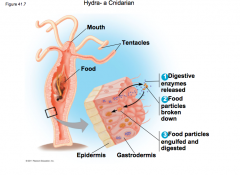
Animals with simple body plans.
This functions in both digestion and distribution of nutrients. |
|
|
Digestive Tract/ Alimentary Canal
|
The digestive tube.
Used in more complex animals which have digestive tube with two openings a mouth and an anus. |
|
|
What is mammalian digestive?
|
system of organs that are specialized for sequential stages of food processing.
|
|
|
What does the mammalian consist of?
|
Alimentary Canal and accessory glands that secrete digestive fluids and enzymes through ducts.
|
|
|
Mammalian accessory glands are?
|
3 pairs of salivary glands
a pancreas a liver a gallbladder |
|
|
what is peristalsis?
|
rhythmic contraction of muscles in the wall of the canal that push food along.
|
|
|
Valves ( Digestion)
|
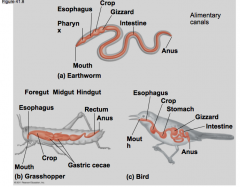
thick rings of smooth muscles called sphincters which regulates the movement of materials between compartments and that also keep compartments separated.
this separation is important because of the different pH and the different enzymatic content of different organs. |
|
|
Dentition and Diet?
|

Carnivores.. Meat Eaters.. has sharp pointy teeth used for ripping and tearing food.
Herbivore.. plant eaters... has flat grinding teeth used for grinding and expanding surface area of food. Omnivore. Both plant and meat eaters with both grinding and and sharp pointy teeth. |
|
|
Oral Cavity, Pharynx and Esophagus
*stages of digestion |
1st stage of digestion is mechanical breakdown of the food and takes place in the oral cavity (mouth).
|
|
|
Salivary Glands
|
Delivers saliva to lubricate food.
|
|
|
Bolus
|
ball in which tongue and mouth shape food.
|
|
|
Pharynx
|
common passageway that opens to both the esophagus and the larynx (which goes to the trachea)
|
|
|
What is the function of the epiglottis
|
triggered by swallowing the epiglottis blocks the entry to the larynx and the bolus is guided by the larynx into the esophagus.
|
|
|
What is the process of chemical digestion (in the stomach)
|
*gastric glands secrete gastric juice which converts food to chyme.
*Gastric juice has low pH off about that kills bacteria * |
|
|
What makes up gastric juice?
|
Hydrochloric acid, water and pepsin.
|
|
|
What is pepsin
|
Is a protease, or protein digesting enzyme that cleaves proteins into smaller pepsin.
|
|
|
Gastric glands
|
Parietal cells secrete hydrogen and chloride ions separately into the lumen (cavity) and secrete intrinsic factor (IF) which binds vitamin B12
Chief cells secrete inactive pepsinogen, which is activated to pepsin when mixed with hydrochloric acid in the stomach Mucous cells secrete mucus which protects the stomach lining from being digested Stem cells are responsible for replacing worn out gland and surface epithelial cells Endocrine cells secrete hormones such as gastrin |
|
|
What is the small intestine
|
*this is the longest section of the alimentary canal.
*it is the major organ of digestion and absorption. you can live without your stomach or large intestion just not your small intestine. |
|
|
What is the Duodenum
|
this is the 1st part of the small intestine where chyme from the stomach mixes with digestive juices from the pancreas, liver and gallbladder and the small intestine.
|
|
|
Secretion of the small intestine ITSLEF
|
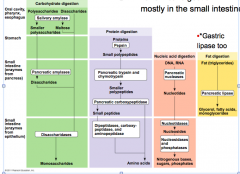
* The epithelial lining of the duodenum produces several digestive enzymes-terminal enzymes (such as disaccharases) that are anchored to the apical surface of the lining epithelial cells.
*enzymatic digestion is continuous as peristalsis moves the luminal contents along the small intestine. *Most digestion occurs in the duodenum and that jejunum, the ileum functions mainly in absorption of nutrients and water and in immunity. |
|

Absorption in the small intestine.
|
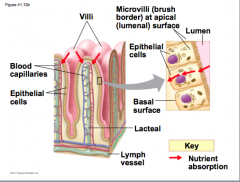
The small intestine has a huge surface area, due to villi and microvilli that are exposed to the intestinal lumen.
*the enormous microvilli surface creates a brush border that greatly increases the surface for and rate of nutrients absorption. *transport across epithelial cells can be passive or active depending on nutrients. |
|
|
What is the function of the hepatic portal vein?
|
carries nutrient rich blood from the capillaries of the intestine to the liver which then sends it into the general circulation.
* the liver filters blood coming from the intestine (and spleen). It is the largest internal organ. |
|
|
What are the function of the Liver?
|
the liver filters blood coming from the intestine (and spleen). It is the largest internal organ.
* the liver regulated nutrients distribution, stores glucose and vitamin A, interconverts many organic molecules (for example makes many non-essential amino acids), and detoxifies many potentially toxic substances, synthesizes cholesterol and lipoprotein particles. |
|
|
Fats NOT absorbed directly into the blood.
|
*Epithelial cells absorb fatty acids and monoglycerides and recombine them into triglycerides.
*these fats are coated with phospholipids, cholestrol, and proteins to form water-soluble chylomicrons |
|
|
What are chylomicrons?
|
Transported in lacteal, a lymphatic vessel in each villus
These lymphatic vessels deliver chylomcrons-containing lymph to large veins that return blood to the heart. |
|
|
Absorption in the large intestine.
|
The colon of the large intestine is connected to the small intestine
The cecum aids in the fermentation of plant material and connects where the small and large intestines meet The human cecum has an extension called the appendix, which plays a very minor role in immunity (and may store “friendly” bacteria |
|
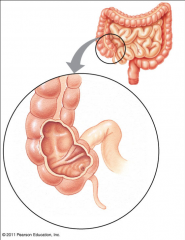
|

A major function of the colon is to recover water that has entered the alimentary canal
The colon houses bacteria (e.g., Escherichia coli) which live on unabsorbed organic material; some produce vitamins Feces, including undigested material and bacteria, become more solid as they move through the colon Feces are stored in the rectum until they can be eliminated through the anus Two sphincters between the rectum and anus control bowel movements |
|
|
what is dentition
|
Dentition, an animal’s assortment of teeth, is one example of structural variation reflecting diet
|
|
|
Mammal success and dental specialization.
|
The success of mammals is due in part to their dentition, which is specialized for different diets
Nonmammalian vertebrates have less specialized teeth, though exceptions exist For example, the teeth of poisonous snakes are modified as fangs for injecting venom |
|
|
Stomach and Intestinal Adaptation.
|
Many carnivores have large, expandable stomachs
Herbivores and omnivores generally have longer alimentary canals than carnivores, reflecting the longer time needed to digest vegetation |
|
|
Mutualistic Adaptations
|
Humans have 10x the number of bacteria living in their intestines (mostly large) than they have body cells
Many herbivores have fermentation chambers, where mutualistic microorganisms digest cellulose The most elaborate adaptations for an herbivorous diet have evolved in the animals called ruminants |
|
|
Regulation of Digestion
|
Each step in the digestive system is activated as needed
The enteric division of the nervous system helps to regulate the digestive process The endocrine system also regulates digestion through the release and transport of hormones |
|
|
Regulation of Energy Storage
|
The body stores energy-rich molecules that are not needed right away for metabolism
In humans, energy is stored first in the liver and muscle cells in the polymer glycogen Excess energy is stored in adipose tissue, the most space-efficient and calorie-dense storage tissue |
|
|
Glucose Homeostasis
|
Oxidation of glucose generates ATP to fuel cellular processes
The hormones insulin and glucagon regulate the breakdown of glycogen into glucose The liver is the site for glucose homeostasis A carbohydrate-rich meal raises insulin levels, which triggers the synthesis of glycogen Low blood sugar causes glucagon to stimulate the breakdown of glycogen and release glucose |
|
|
Regulation of Appetite and Consumption
|
Over nourishment causes obesity, which results from excessive intake of food energy with the excess stored as fat
Obesity contributes to diabetes (type 2), cancer of the colon and breasts, heart attacks, and strokes Researchers have discovered several of the mechanisms that help regulate body weight Many mechanisms involve the hypothalmus of the brain |
|
|
Obesity and Evolution
|
A species of birds called petrels become obese as chicks; in order to consume enough protein from high-fat food, chicks need to consume more calories than they burn. Other birds too.
The problem of maintaining weight partly stems from our evolutionary past, when fat hoarding was a means of survival Individuals who were more likely to eat fatty food and store energy as adipose tissue may have been more likely to survive famines |

